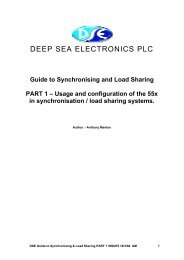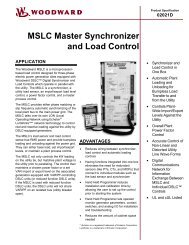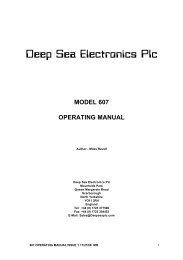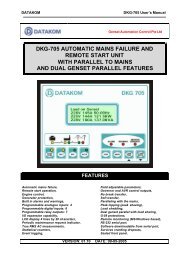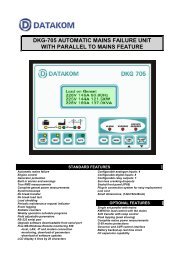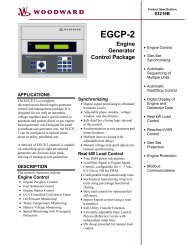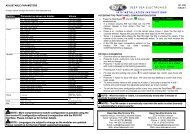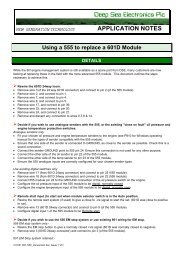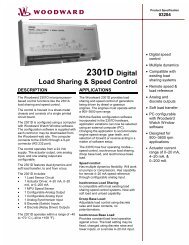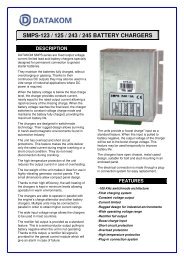Operation Manual - Home Mega Global Solution
Operation Manual - Home Mega Global Solution
Operation Manual - Home Mega Global Solution
Create successful ePaper yourself
Turn your PDF publications into a flip-book with our unique Google optimized e-Paper software.
The engine is cranked for the duration of the crank timer or when the engine fires, the starter motor isdisengaged and locked out at a pre-set frequency from the Alternator output. Alternatively a MagneticPickup mounted on the flywheel housing can be used for speed detection.Should the engine not fire on the first attempt and the crank timer expires, the module will rest thestarter for the duration of the crank rest timer. Once this has expired the module will once againattempt to start the engine. This will be repeated until either the engine fires or the pre-set number ofattempts to start have been completed, in this instance the module will indicate a ‘Fail to start’alarm.NOTE:- Should a ‘Fail to start’ alarm occur the module must be placed intoSTOP/RESET mode by pressing the STOP/RESET PUSHBUTTON. Determine why theengine failed to fire before making any further attempts to start.After the starter motor has disengaged, the Safety On timer is activated, allowing Oil Pressure, HighEngine Temperature, Underspeed, Charge Fail and any delayed Auxiliary fault inputs to stabilisewithout triggering the fault.Once the engine is running and the safety on timer has expired, full fault protection is made availablethis being indicated by illumination of the ‘SAFETY ON’ LED.Once the generator is running at the correct speed and up to voltage the ‘GENERATOR AVAILABLE’LED will illuminate on the mimic diagram to indicate that a transfer of the load to the generating setmay now take place.Pressing the STOP/RESET PUSHBUTTON will de-energise the Fuel Solenoid and bring the engineto rest.1.3 AUTOMATIC MAINS FAILURE/REMOTE ON LOAD OPERATIONIf the module is placed in ‘AUTO’ mode by pressing the ‘AUTO’ PUSHBUTTON, it will monitor boththe incoming mains supply and also monitor the auxiliary inputs for a ‘REMOTE START ON LOAD’signal. Should either the incoming mains supply fail (or fall outside of pre-set limits) or the ‘REMOTESTART ON LOAD’ signal be detected, the following sequence will occur.The module will start its ‘Start Delay’ timer, this is used to ensure that the start event is reallyrequired and the failure is not just a momentary dip in the supply. Once this timer has expired themodule will continue with its normal start sequence.If the pre-heat output option is selected this timer is then initiated, and the auxiliary output selectedis energised.Should either the mains return or the remote start signal be removed during either of the above twotimers, the module will terminate its start sequence and return to its standby ‘AUTO‘ state until suchtime as a start is signalled again.After the pre-heat timer has expired the module will de-energise the pre-heat output and commenceengine starting; the following sequence occurs. The Fuel Solenoid is energised, then the StarterMotor is engaged.The engine is cranked for the duration of the crank timer or when the engine fires, the starter motoris disengaged and locked out at a pre-set frequency from the Alternator output. Alternatively aMagnetic Pickup mounted on the flywheel housing can be used for speed detection.Should the engine not fire on the first attempt and the crank timer expires, the module will rest thestarter for the duration of the crank rest timer. Once this has expired the module will once againattempt to start the engine. This will be repeated until either the engine fires or the pre-set number of6606 OPERATING MANUAL ISSUE 2 11/27/00 MR



